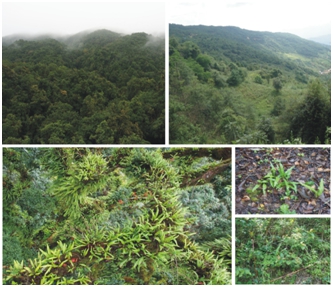Epiphytic ferns are an important group of plants strongly affected by sudden changes in forest community composition and structure. However, limited information exists on the degradation of epiphytic fern populations in the subtropics, while little is known of how their life history, distribution pattern, and functional traits vary during forest degradation.
Researchers from Xishuangbanna Tropical Botanical Garden (XTBG) investigated the vertical distribution of Lepisorus scolopendrium and L. bicolor, two congeneric co-occurring deciduous epiphytic fern species, in a subtropical primary forest and its two-stage degraded forests in Ailao Mountains, SW China. The finding has been published in Forest Ecology & Management.
Their field survey revealed distinct distribution patterns of the two epiphytic ferns in the primary and two degraded forests. They also found clear patterns of functional traits and the plasticity of epiphytic ferns during forest degradation.
The two ferns shifted from obligate to facultative in secondary forests and inhabited a narrower vertical distribution range than primary forest. The relative abundance in the 0–2 m segment and terrestrial (ground surface) habitat increased with canopy openness during forest degradation.
The researchers found that the rapid response of functional traits to forest degradation adjusted the annual growth pf rhizomes. Rhizome lengthening dynamics in the two fern species enabled whole plant movement.
Therefore, higher annual growth pf rhizomes of terrestrial individuals in secondary forests implied that ferns are apt to seek out new optimal habitats after forest degradation, rather than colonize the immediate surrounding area through accumulated plant biomass.
“Our findings demonstrate that, in response to forest degradation the two canopy-dwelling ferns tended to occupy the lower tree trunk and understory ground, by the intraspecific adjustment of key functional traits to promote rhizome growth and expansion in search of suitable habitat”, said Prof. LIU Wenyao, principal investigator of the study.
Contact
LIU Wenyao Ph.D Principal Investigator
Key Laboratory of Tropical Forest Ecology, Xishuangbanna Tropical Botanical Garden, Chinese Academy of Sciences, Mengla, Yunnan 666303, China
E-mail: liuwy@xtbg.ac.cn

Two epiphytic ferns in AIlao mountains.
(Images by CHEN Quan)

